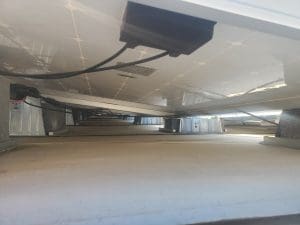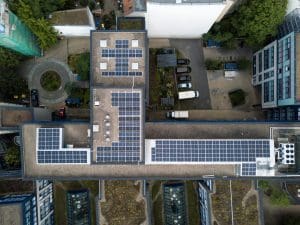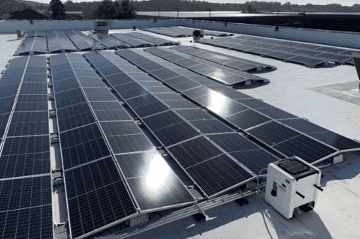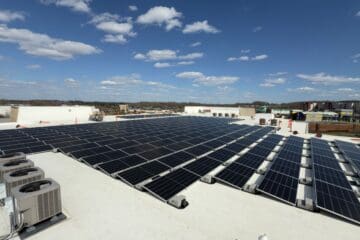Customers often want to know as much as they can about different panel options when considering an array: what each has to offer & what the best option would be in their system So here’s our first list comparison of some of the different panel products we offer. Throughout this list we’ll navigate the various characteristics of both the module and the company behind them, providing you with details educating you on what kind of a product you are getting and what the manufacturer focuses on between durability, longevity, robust warranty, or higher power production.
Photo credit: Trina Solar
1. Trina
Trina Solar has been leading the solar module manufacturing industry since 1997 and has shipped over 100 gigawatts of solar modules. Their commercial Vertex line is designed for higher efficiency and power output by utilizing 210 mm monocrystalline cells (as opposed to polycrystalline). What’s the difference? Monocrystalline is one continuous sliver of silicone cut from a crystalline rod, while polycrystalline is a mix of silicone crystalline put together in a given cell. Monocrystalline panels typically deliver a higher efficiency output. Their Vertex line is able to put out 670 W with a 23% efficiency in test conditions which is extremely high. (To give some context, older residential systems that were installed in 2012 have panels that output 190 W). The R&D team at Trina has broken 23 world records through module efficiency and panel output while developing their module technology.
What would it mean for your system if you chose to go with Trina? The reason why Trina is focusing so much on high output & efficiency is to minimize needed roof or land area for solar arrays, while still producing the same amount of power as larger installs. The modules themselves are large- standing at over 7 feet tall and almost 4 1/2 feet across. This is part of what allows for the higher output per unit. So the module size is something to keep in mind when reviewing the array design.
Additionally, Trina has ensured widespread compatibility. Vertex is compatible with nineteen of the main inverter brands (translating to over 180 individual inverter models). Installing Trina modules is a solid choice with durability, compatibility and the long warranty you have with their equipment.
Notable arrays utilizing Trina modules: a 100 MW agrivoltaic project located in China’s Hubei province that went online in the summer of 2021. Trina’s Vertex 550 W modules were used. The array covers 160 hectares and produces 110 million kWh of energy annually. More recently, Trina won the bid to build a 50 MW floating solar farm in a hydroelectric reservoir in Malaysia.
Read Also:
Photo credit: Phono Solar
Phono Solar has been operating in the solar module industry since 2007. As a much younger company, it has shipped out 20 GW in modules equipment. Its main operations are located in Asia with offices in Europe, Australia and the United States. Phono’s commercial modules are smaller than the Trina’s standing at about 6.5 feet in height and 3 1/4 feet across. As part of their R&D, Phono has focused heavily on panel efficiency in all conditions: lower reflective glass that is ‘ultra clear’ helping sun ray transmittance directly to the crystalline surface, avoiding micro cracks in the panel glasstop, and resistance against sand dust and snow pressure- all factors that can pull down efficiency. Phono has an optimal efficiency of almost 26% which is one of the highest (if not the highest) in the industry.
Phono has also done quite a bit with module durability, keeping the equipment producing at optimal output for as long as possible, attention to detail with junction box sealing, and resistance to weather elements and water absorption. Phono has several module lines including TwinPlus, Draco and a Bifacial model. They pay attention to the need for sizing options and versatility by providing both a smaller framed 60 cell module and a larger framed 120 cell module for customers to choose from, allowing for rooftops that may have sizing limitations. For customers that want to keep costs under a certain amount, Phono is a great option to consider as it manufactures some of the most cost-effective panels on the market.
Notable installs utilizing Phono Solar modules: 49 MW ground mount in Dongying China; a 10.92 MW rooftop array in Hefei China; numerous multi-MW arrays in Germany, the U.S. and the U.K. proving that Phono has scalability for all types of installation applications.
Photo credit: Mission Solar
A big draw to Mission Solar is that their operations are based in the U.S. Based in San Antonio, TX, the company launched in 2013 and have since developed some of the most efficient and trustworthy panels in the U.S. market. They also have a stellar 25-year power and product warranty. Since they are Buy American Act-compliant, they have worked with almost every branch of the federal government installing their panels on governmental buildings.
Their commercial modules have a lower power rating than some of the others on this list with 425 W being their highest wattage producer. They are still a large-sized module standing at 6.84 feet in height and 3.5 feet in length, so it’s something to consider when trying to achieve a certain building offset with a finite rooftop space.
Their R& D teams have focused specifically on the durability of their products (thus the long warranty). They’ve even got a kitschy video on all the ways their panels pass the durability test. Hey, we’re in a new-tech business of creating sun energy, you’ve got to let loose sometimes.
Some notable installations utilizing Mission modules are a roof mounted 798 kW system + storage located in Oxen Hill MD and 800 kW on Ft. McNair in Washington D.C.
Main photo credit Rob Miller @unsplash







2 Comments
Comments are closed.